
Blue-winged Olives
Baetis
Tiny Baetis mayflies are perhaps the most commonly encountered and imitated by anglers on all American trout streams due to their great abundance, widespread distribution, and trout-friendly emergence habits.
Featured on the forum

I was not fishing, but happened to be at an unrelated social event on a hill above this tiny creek (which I never even saw) when this stonefly flew by me. I assume it came from there. Some key characteristics are tricky to follow, but process of elimination ultimately led me to Sweltsa borealis. It is reassuringly similar to this specimen posted by Bob Newell years ago. It is also so strikingly similar to this nymph from the same river system that I'm comfortable identifying that nymph from this adult. I was especially pleased with the closeup photo of four mites parasitizing this one.

Troutnut is a project started in 2003 by salmonid ecologist Jason "Troutnut" Neuswanger to help anglers and
fly tyers unabashedly embrace the entomological side of the sport. Learn more about Troutnut or
support the project for an enhanced experience here.
Caddisfly Species Polycentropus cinereus (Brown Checkered Summer Sedges)
Where & when
Time of year : June through August; best from mid-June through early July
Preferred waters: Lakes and streams
In 41 records from GBIF, adults of this species have mostly been collected during June (41%), July (32%), August (15%), and May (7%).
In 7 records from GBIF, this species has been collected at elevations ranging from 361 to 5449 ft, with an average (median) of 4964 ft.
Larva & pupa biology
Current speed: Slow
Environmental tolerance: Best in cool, clear water
Shelter type: Larvae live in a silk tube used as an ambush point, or build a net to capture prey
Start a Discussion of Polycentropus cinereus
References
- LaFontaine, Gary. 1981. Caddisflies. The Lyons Press.
- Swisher, Doug and Carl Richards. 2000. Selective Trout. The Lyons Press.

